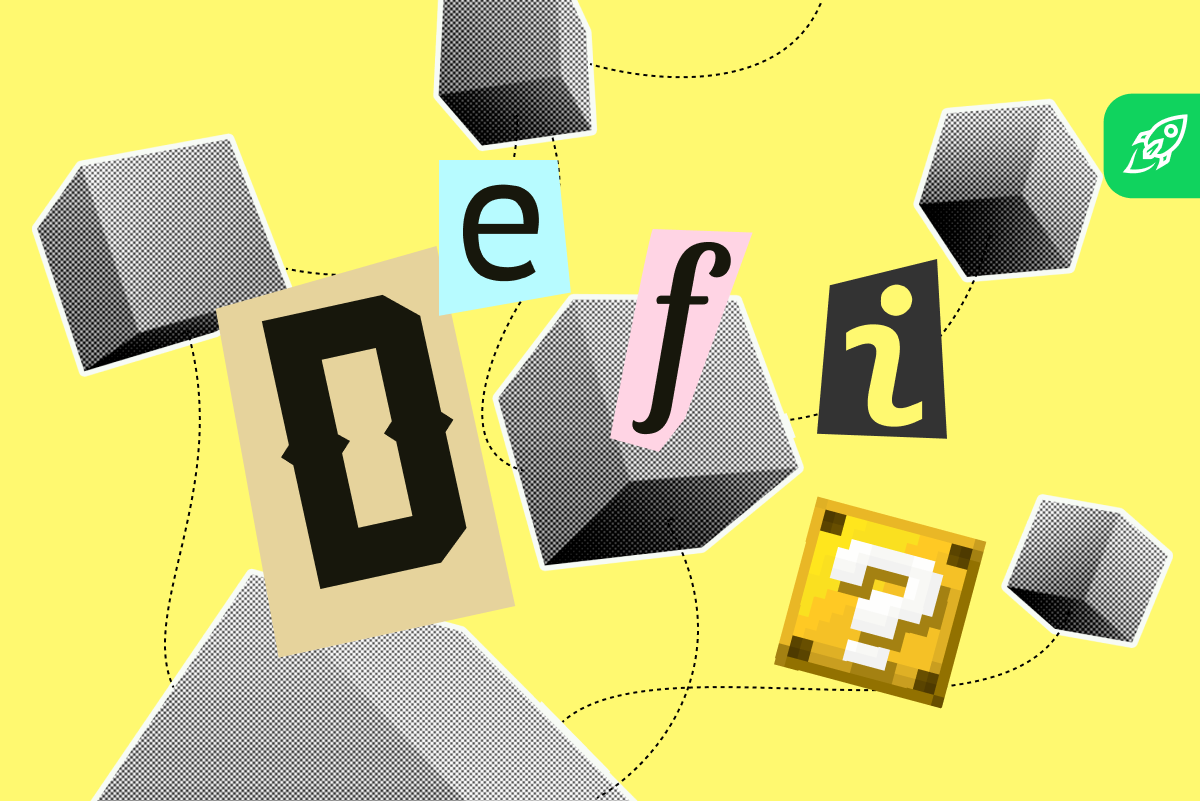Hardly anyone who has any sort of involvement in the crypto space hasn’t at least heard about decentralized finance (DeFi).
While decentralization has been the main focus of all things crypto, there’s no other field in the blockchain industry that embraces it as well as DeFi does. Its main goal is to provide users with fully-functional and efficient decentralized alternatives to all mainstream financial services such as loans, storage, and so on.
Why do we need DeFi? Well, for the same reason we need blockchain technology — there’s a serious lack of privacy and transparency in the modern world. Decentralized finance aims to eliminate third-party involvement in people’s businesses and personal lives by creating fully secure and anonymous financial services.
Understanding DeFi
When you make a transaction via a traditional financial service like a bank, your data gets recorded in a private ledger (your transaction history) by that institution and will be kept and managed by them. Blockchain, on the other hand, records your transactions in encrypted code on a distributed public ledger that can be accessed by all the parties that use those particular DeFi applications.
Although blockchain and crypto themselves are fully decentralized, there are still centralized crypto-related services, such as cryptocurrency exchanges. CEXs share some of the pros and cons of traditional financial institutions but offer a comparatively higher degree of privacy. They can be seen as the middle ground between conventional banks or brokerages and DEXs.
What Are the Components of DeFi?
DeFi applications use smart contracts and the distributed ledger technology (DLT) to offer decentralized versions of a wide range of traditional financial products and services.
Prediction Markets
Conventional centralized prediction markets have always been in great demand. Today, with the help of DeFi, we’ve got a chance to make them more open and decentralized. Here are three main advantages of peer-to-peer (P2P) prediction markets over centralized ones:
No restrictions. Anyone from Alaska to South Africa can participate in a P2P prediction market.Open-source code. Unlike closed-source centralized prediction markets, peer-to-peer markets are publicly available, and all the transactions can be seen in the blockchain. Trust. Users don’t need to trust anyone but the code and themselves. There is no third party that holds your funds. You are responsible for and in control of your digital assets.
The most recognizable P2P protocol for prediction markets is Augur — a decentralized oracle which consists of smart contracts and can be easily deployed to the Ethereum network. Essentially, Augur is not a prediction market itself but an open-source software. The main advantage of decentralized platforms for prediction markets is that they are censorship-resistant. No one in the world can control them as the code is the law. However, anyone can participate in speculation on a number of events. Augur can be used in a wide range of various sectors from weather forecasting and sports prediction to financial and political events.
DeFi projects: Augur, Gnosis, Helena.
DeFi Insurance
Smart contracts provide new, enhanced solutions to age-old problems. When you are afraid of being robbed, you usually insure your goods. The same logic works for the blockchain industry. There are already DeFi projects that guarantee compensation for your losses. Projects like Etherisc and Nexus Mutual cover your back using the power of smart contracts.
Insurance decentralized applications aim to enable lower operational costs, democratize access to reinsurance, and bring transparency to businesses.
Flight Delay Insurance is the first ever insurance dApp. It was launched on the Ethereum blockchain in 2016. The Etherisc team introduced a fully-licensed application with automatic and almost instant payouts — if your flight is delayed for 45 minutes or more, the payouts will be initiated immediately once you land. No need for paperwork and bureaucracy — just fill in a form on their website to receive your insurance.
Etherisc is also working on other important insurance dApps like Social Insurance, Collateral protection for crypto-backed loans, Crop Insurance, and Crypto Wallet Insurance. The latter is a promising project that will allow you to store your funds in a crypto wallet without having to worry about it being hacked.
DeFi projects: Etherisc, Nexus Mutual, VouchForMe.
Exchanges
Decentralized exchanges or DEXs have been on the market for almost 3 years. Being built predominantly on top of the Ethereum blockchain (the most popular platform for a dApp deployment), DEXs provide real-time digital money trading along with high transaction throughput. Trading in a peer-to-peer (P2P) way has many advantages, like lack of central authority, total transparency, accessibility, and so on. Additionally, transactional fees are usually lower compared to the average centralized exchange, as DEXs have much lower expenses on maintenance work.
However, as DEXs are relatively new to the crypto industry, there are some imperfections like high gas fees (for Ethereum dApps), low trading volumes, non-user-friendly UX/UI, and so on. Nevertheless, the niche of decentralized exchanges is growing rapidly, providing opportunities for decentralized margin trading, peer-to-peer (P2P) instant swaps, and many more.
DeFi projects: IDEX, EtherDelta, Oasis, WhaleEx, Fulcrum, BinanceDEX.
Stablecoins
A stablecoin is another vital entity that supports and improves the decentralized financial industry. Stablecoins are cryptocurrencies aimed at decreasing the volatility of a coin’s price. They can be pegged to fiat currencies like the USD (USDT, TrueUSD), the EURO (Stasis EURO), or other exchange commodities like gold (DGX) or even BTC (imBTC).
The mechanism and importance of stablecoins in the DeFi industry are vividly demonstrated by the MakerDAO DeFi protocol and its stablecoin DAI.
DAI aims to bring financial freedom with no volatility to everyone. You can instantly generate the stablecoin on your terms while getting income for holding DAI.
DeFi projects: USDT, GUSD, BUSD, DAI, EOSDT.
Lending and Borrowing
Another branch of DeFi is P2P lending and borrowing platforms. Lending platforms, built on a particular blockchain, make borrowing and lending faster and more accessible to people.
One of the greatest advantages of lending marketplaces (besides the lack of any third parties) is that they provide an assurance in the form of cryptographic verification methods. Decentralized lending platforms offer not only loans but also an opportunity to earn interest.
Open Lending Protocols
DeFi lending protocols make truly decentralized lending possible. Projects such as Compound, Dharma, and Aave bring lending to a new level by enabling a different way to get passive income and earn interest on one’s funds — liquidity pools.
Here’s how they work: lenders deposit their funds in a liquidity mining pool contract. At the same time, by placing collateral, users can borrow those funds. The interest rates are calculated algorithmically. As a borrower takes an amount of funds from the pool, the amount of funds available in that pool decreases. Consequently, the interest rates also increase. The lender’s interest rate corresponds to the earnings rate which is protected by the algorithm.
DeFi projects: Compound, Dharma, Aave, NUO network.
Pros and Cons of DeFi
DeFi services can offer users quite a few benefits. Here are just some of them:
Privacy
Unlike the usual brokerages or banks, DeFi platforms do not require user authentication: you won’t have to submit a proof of residence, a government-issued identification, or a social security number. You can take full advantage of decentralized financial services without compromising your privacy and anonymity.
Immutability
The use of cryptography and consensus algorithms such as proof-of-work has allowed blockchain technology to achieve immutability — meaning it is practically impossible to alter and/or manipulate any data on a blockchain network. This makes DeFi platforms a lot more secure than traditional financial service providers.
Transparency
The transparent nature of blockchain technology allows DeFi platforms to provide their users with fully secure financial services without sacrificing integrity. Distributed ledgers that are used in DeFi products contain information about all the activities that take place on a specific blockchain network, making it easy to identify and catch scams and criminals that want to manipulate transaction data.
Tokenization
DeFi promotes tokenization — a process of replacing sensitive data with tokens that have no external value or significance. It helps to prevent data theft, reduces settlement time and costs, improves liquidity, and increases transparency, making it indispensable to the financial industry.
However, there are also quite a few things that make experts worry that DeFi may not become the norm. Here are three main issues that investors are concerned about:
Liquidity
Although there is currently quite a lot of money locked in various DeFi protocols (to say the least), that number is still a lot lower than the amount of money that circulates in traditional financial systems. This issue will most likely be solved once the DeFi sector becomes bigger, but currently there are still concerns as to whether it can efficiently support a larger number of operations.
Scalability
While DeFi aims to provide a permissionless financial system to the wider population, there are concerns as to how it will behave when the amount of transactions going through decentralized finance services grows tenfold. There are blockchains that have the capability to process a large number of operations for a negligible fee, but many popular networks still have trouble dealing with high congestion periods.
Instability
Uncertainty and volatility are currently pretty much inseparable from blockchain technology. Instability is the last thing anyone would want from their financial products and service providers, and yet it accompanies almost, if not all the DeFi projects. From crypto regulation to blockchain updates, there are many factors that can mess up the normal operation of DeFi platforms, making them less reliable than an average traditional financial institution.
How Can DeFi Help the Financial Services Sector?
DeFi has a lot to offer to the financial services sector. The democratization DeFi apps offer to users can provide substantial benefits to small and big businesses alike, and the increased integrity of decentralized applications can help to combat manipulation and tax evasion. Decentralized finance can help to build a more secure, accessible financial system that will benefit all of its participants (excluding criminals, of course!).
Does DeFi Have a Future?
As we have mentioned in the pros and cons section, there are quite a few issues that the DeFi sector still has to deal with. How well it deals with those problems will ultimately determine whether it will manage to overtake the traditional financial sector or not.
There’s no denying that the world is ready for some big changes. With money and business rapidly digitizing, DeFi may play a major role in the economy in the future. Because decentralized applications are built using blockchain technology, many people think that the decentralized financial ecosystem can only be used to lend, borrow, and trade cryptocurrencies — but that is not the case. It has the potential to revolutionize the whole traditional financial world.
DeFi has a much wider reach than just crypto — it democratizes all the elements of finance, offering users from all over the world greater access and autonomy when it comes to their funds. With the rise of services like VPNs, it’s clear that users are becoming increasingly concerned about the safety of their personal information, so we think that DeFi will only continue to gain popularity as time goes on.
FAQ
What is DeFi banking?
DeFi banks are decentralized financial applications that let users take advantage of the usual banking services like lending without any middlemen or creating a bank account.
What does DeFi mean for Bitcoin?
The DeFi sector and its further development will likely benefit cryptocurrencies like Bitcoin in the long term. Additionally, DeFi tokens and BTC have different use cases and utility, so they are not directly competing with each other.
Why is DeFi popular?
DeFi allows financial services to remove the middlemen in transactions and gives users higher autonomy, privacy, and security when it comes to managing and using their funds.
What is a DeFi application?
DeFi apps are decentralized applications that use smart contracts technology to provide users with trustless, secure, and permissionless financial services.



